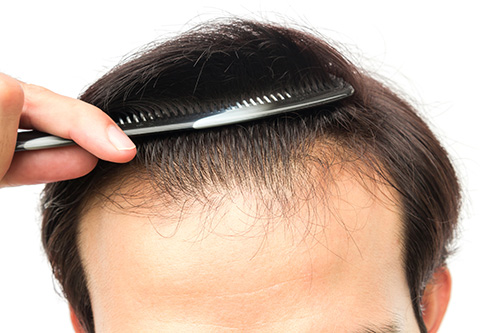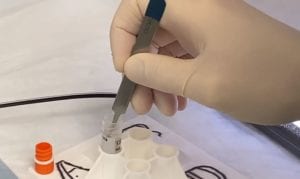‘We’re not making new hairs; we’re rescuing hair follicles’: could scientists reverse male pattern baldness?
By: Hannah Devlin | @hannahdev
Sun 1 Oct 2023 05.00 EDT | Reprint from The Guardian
The onset of hair loss can be devastating for some men. But research into experimental cell therapy is offering hope of keeping baldness at bay.
Paul Kemp’s introduction to the issue of baldness came as a rude awakening while getting a haircut at the age of 20. “I remember my hairdresser looking down and saying, ‘Oh my God, you’re going bald on top’.”
Kemp, now in his 60s, was dismayed at the discovery, but it also marked the beginning of a lifelong professional interest in the science of hair loss and how to stop it. Kemp is the co-founder and chief executive officer of HairClone, a company that is developing an experimental cell therapy treatment for male pattern baldness and whose tagline is “making hair loss history”.

Male pattern baldness affects around 85% of men by the age of 50 and losing hair can be a source of anxiety and low self-esteem. There are drugs that can slow hair loss, transplants to redistribute hair around the head, or strategic hairstyles to disguise receding hairlines and bald spots. Nothing exists to reverse the process, but that could be set to change.
In recent years, scientists have discovered that baldness has its origin in the loss of specialized skin cells, called dermal papillae, that line the base of hair follicles. These cells are crucial for regulating hair thickness, growth, texture and possibly even color. But in some men, these cells are progressively killed off by dihydrotestosterone, the hormone that causes the male body to mature during puberty.
“You have about 1,000 of these dermal papilla cells per hair,” says Kemp. “The more dermal papilla cells, the thicker the hair shaft. When you get down to around half that number, you’ll notice the hair thinning.”
Baldness implies a lack of hair, but, technically, bald heads are not hairless. As dermal papilla cells are lost, the follicle shrinks and the hair shaft it produces becomes finer and spends longer in the dormant state. Eventually, the hairs become so fine and grow so slowly that they are effectively invisible.
HairClone aims to reverse this so-called miniaturization process by allowing people to bank 100 or so youthful follicles or follicles from parts of the head that still have hair. After being taken from a patient’s head, the follicles are placed in a deep freeze container at -150C. Then, as, and when required, the hair can be thawed, and the dermal papilla cells can be cloned and multiplied in the laboratory to provide an almost unlimited supply.
The hope, based on experiments in mice and previous tests in people by an earlier company, is that injecting the cells back into the scalp will plump the follicles and return hair to a more youthful state.
“We’re not making new hairs, we’re rescuing miniaturizing hairs,” says Kemp.
Around 200 clients have already banked hair, although none have yet been treated. The efficacy of the approach has not yet been established in a clinical trial, but the company is in the process of establishing quality controls that will allow it to manufacture cells to clinical standards. At that point – and the company is hoping that will be within the next 12-18 months – doctors will be able to offer it on an experimental basis to patients who they think could benefit.
One of those to have banked his hair is Tommy Smith, a 65-year-old planning consultant, who lives in Red Oak, North Carolina. Smith initially began losing hair in his 20s, possibly as a side-effect of powerful acne medications, including high dosages of prescription vitamin A.
This could provide young men who have a hair loss history in their family the opportunity to address future loss in a much less painful and complicated manner.
 He sees hair cloning as insurance against further hair loss. “The concept of having hair follicles stored to address the potential of additional hair loss in the future is very encouraging,” he says. “I also think this could provide young men who have hair loss history in their family the opportunity to address future hair loss in a much less painful and complicated manner.”
He sees hair cloning as insurance against further hair loss. “The concept of having hair follicles stored to address the potential of additional hair loss in the future is very encouraging,” he says. “I also think this could provide young men who have hair loss history in their family the opportunity to address future hair loss in a much less painful and complicated manner.”
Smith’s experience highlights the dilemma that hair surgeons and their patients are faced with when planning a transplant. Once transplanted, follicles retain their original identity and so need to be taken from a safe zone of the scalp that is not destined to go bald in the future. Transplanting before the hairline has stabilized can lead to a “hair island” effect, requiring further transplants – and there’s also a question of whether the hairline will recede so far that there won’t be sufficient hair to spread over the whole head. “You’re chasing a moving target,” says Kemp.
However, scientists believe it may be possible to predict a man’s eventual hairline by analyzing genetic markers hidden inside dermal papilla cells, meaning that in the future men could make more informed choices about the most appropriate treatment.
“There’s always been this clear pattern of male hair loss, but no one’s really explained why it’s like that,” says Dr Claire Higgins, a lecturer in tissue regeneration at Imperial College London and scientific adviser to HairClone.
 In a paper published in May, Higgins described evidence that the hairline of a middle-aged man could be traced back to the earliest stages of embryonic development. Around the third week of an embryo’s life, cells form three layers called the ectoderm, mesoderm, and endoderm. Most organs in the body contain cells that derive from just one of these lineages: the endoderm gives rise to the internal organs, the mesoderm becomes the muscle and connective tissues, and the ectoderm becomes the central nervous system. “Normally a tissue is one lineage, but the [skin] is a bit of an enigma,” says Higgins. “The dermis [the skin’s lower layer] on the face is ectoderm and the dermis on your body is mesoderm, but the top of your head is not really known.”
In a paper published in May, Higgins described evidence that the hairline of a middle-aged man could be traced back to the earliest stages of embryonic development. Around the third week of an embryo’s life, cells form three layers called the ectoderm, mesoderm, and endoderm. Most organs in the body contain cells that derive from just one of these lineages: the endoderm gives rise to the internal organs, the mesoderm becomes the muscle and connective tissues, and the ectoderm becomes the central nervous system. “Normally a tissue is one lineage, but the [skin] is a bit of an enigma,” says Higgins. “The dermis [the skin’s lower layer] on the face is ectoderm and the dermis on your body is mesoderm, but the top of your head is not really known.”
Higgins argues that male pattern baldness traces the boundary between skin cells that have taken two very different paths during development. This, she says, could explain why the cells on only certain parts of the head are oversensitive to dihydrotestosterone.
Kemp and colleagues are working to develop a test, based on the gene expression of dermal papilla cells, to establish whether the part of the scalp they come from is balding, destined to bald or will always retain its hair. “Ideally you want to be able to map the head,” he says. “We’re finding genetic differences between the hairs and we’re in the preliminary phases of doing that.”
Kemp says that after years of living with hair loss, he is comfortable with his appearance – and treatment is not for everyone. “At this stage, I’m used to looking like this,” he says. “But when I was 20, had they said, there’s something we can do about that, I would’ve done it. Our targets are younger people.”
Full Article @: https://www.theguardian.com/lifeandstyle/2023/oct/01/could-scientists-reverse-male-pattern-baldness-hair-loss-cell-therapy
